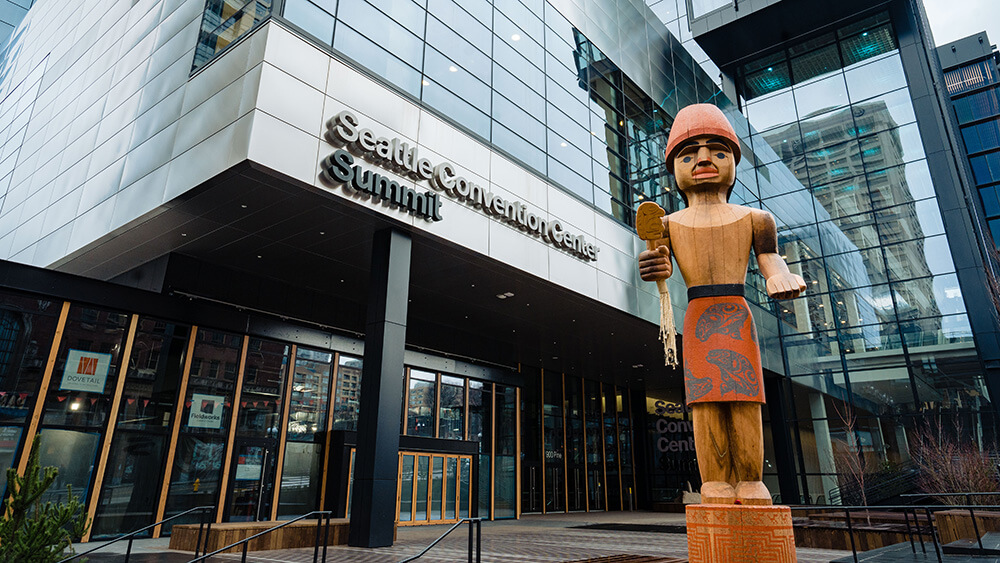
Mowitch Man, one of two Coast Salish welcome figures carved by artist Andrea Wilbur-Sigo, stands outside the Seattle Convention Center’s Summit building. The building houses works by nearly two dozen Seattle-area artists. (Corey Parris/Visit Seattle)
When I arrived at the Hyatt Regency Seattle before check-in on a drizzly Sunday afternoon in late February, my hosts gave me a key to the hotel’s eighth-floor executive lounge. I settled into a corner chair with a cup of tea, where I had a bird’s-eye view of the primary reason I had come to town — to see the Seattle Convention Center’s Summit building, which opened earlier this year, in action.
I had the lounge to myself until Dr. Anthony Fauci, former director of the National Institute of Allergy and Infectious Diseases, came in for a post-workout snack, accompanied by security. Fauci, along with 3,000 researchers, clinicians, and public health professionals, also were bound for the new convention center space — in their case, for the 30th Conference on Retroviruses and Opportunistic Infections (CROI), which started the same day I arrived.
The new building breaks ranks with convention in more ways than one — it is a block-and-a-half away from the city’s three-decades old convention center, formerly the Washington State Convention Center. That makes Seattle “the only city I’m aware of with two convention centers in the heart of downtown,” Kelly Saling, senior vice president and chief sales officer at Visit Seattle told Convene. (Last year, the buildings were renamed the Seattle Convention Center, and the original building is now called Arch building.) Embarking on new construction in Seattle’s busy downtown core, rather than in a less-central location, was challenging, Saling said, but the reward is that location immerses the center’s visitors into the life of the city.
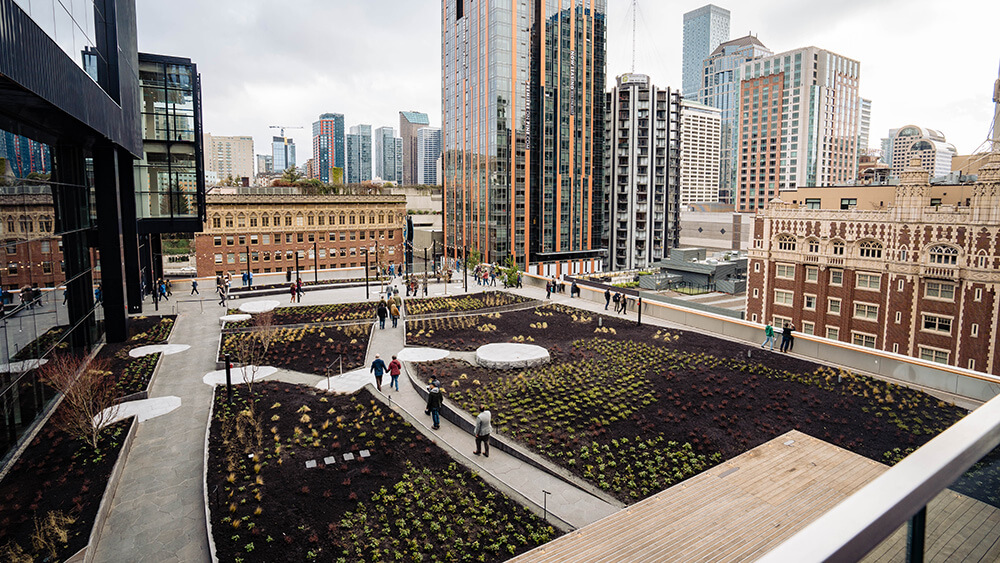
The Summit building’s ballroom-sized terrace lends visitors a view of the center’s vegetable garden. (Corey Parris/Visit Seattle)
An Almost Perfect Walk Score
I was eager to immerse myself in the city, too — when I typed the hotel’s address into walkscore.com, which ranks places for walk ability and access to dining, shopping, green space, and more, it scored an impressive 99 points out of 100. The blocks between the hotel and the city’s waterfront are lined with coffee shops, restaurants, and retail stores, but I made a beeline for a visitor favorite less than 10 minutes away: Pike Place Market, a more-than-century old warren of restaurants, shops, and covered stalls overlooking the Puget Sound.
Filled with flowers, produce, and seafood, Pike Place, which was founded in 1907 as a farmers market, was a riot of color, smells, and sounds. The nine-acre market is now home to more than 500 small businesses, including restaurants ranging from seafood to Moroccan fine dining to a 30-year-old Russian bakery selling piroshkis, a kind of turnover with savory fillings. The market’s half-mile-long loop has more than 100 local shops, including Eighth Generation, owned by the Snoqualmie Tribe, which sells Native-designed jewelry, textiles, and prints.
I tore myself away to meet Jared Dionne, Visit Seattle’s public relations manager for meetings and conventions, at the Audacity wine bar, across the street from Arch. The cozy space, operated by the family-owned Alexandria Nicole Cellars in Washington’s Columbia River Valley, serves award-winning wine in an easygoing atmosphere. As I walked back to the Hyatt Regency, bathed in the red neon glow of the sign in front of the landmark 1928 Paramount Theater, I had to remind myself that I was in the middle of a convention center campus.
Later in the week, I toured both buildings, beginning with Arch, where the American Booksellers Association Winter Institute was in full swing. Even though the center was built three decades ago, it feels fresh, thanks to updates, but also because it was ahead of the curve in terms of its connection to the surrounding neighborhood and its inclusion of light and green space. The 434,988-square-foot center’s street-level first floor holds cafés and a coffee shop; the third level opens out on Freeway Park, a tree- and art-filled green space built over an interstate.
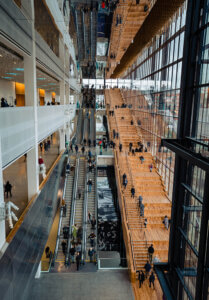
The Summit building uses acres of glass walls and an oversized, four-story staircase, which doubles as a gathering place, to connect meeting participants to the heart of Seattle’s downtown. (Corey Parris/Visit Seattle)
Summit takes those elements — creating links to the surrounding city and abundant natural light and natural materials — and leapfrogs into the future. Its acres of glass walls make it feel as if there is only a thin membrane between the center and the city’s downtown skyscrapers and floods the building with light, aided by a skylight that filters light to every floor, down to the basement level. The building is filled with wood — much of it reclaimed — including more than 3,900 planks salvaged from the state’s timber industry, which hang from the ceiling of a 60,000-square-foot main ballroom.
The day I visited, the center hummed with activity — CROI, which brings together experts in the fields of HIV/AIDS, viral hepatitis, and other infectious diseases, was meeting in person for the first time since 2019, said Donna Jacobsen, CROI’s executive manager and executive director/ president of the International Antiviral Society– USA. Attendees, who must apply to attend, are laser-focused on two things: hearing presentations and meeting with colleagues, Jacobsen said. “For our group, that networking is essential.”
Unlike some other unnamed convention centers, Jacobsen said, Summit is light, bright, and inviting, making it a pleasure to spend time inside the meeting rooms. Wind conditions during the event prevented CROI from using the 14,000-square-foot terrace on the third floor, but even inside the center, Jacobsen said, “you really felt like you were partially outside.”
One of the building’s most striking elements is a wide staircase rising diagonally along the glass wall on the south side of the building, accessible from four levels. Escalators run alongside the staircase, known as the Hillclimb, which was dotted with CROI meeting participants working alone on laptops or talking in twos or threes. The flexible, central space “makes it possible,” Saling said, “to see people in a way that you don’t when you’re in a more traditional meeting space.”
With 573,770 square feet of event space, Summit nearly doubled downtown Seattle’s convention center space, and the two buildings open new possibilities for overlapping citywide conferences and co-locations. Saling and her staff sometimes feel as they are playing Tetris as they work out how to put all the puzzle pieces together, she said. And like in Tetris, there are lots of blocks in different shapes and sizes to work with, including more than 8,500 hotel rooms within a six-block radius of the convention center campus.
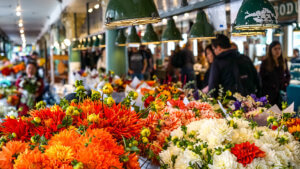
Pike Place Market, founded on the waterfront in 1907, is home to 500 small businesses and eateries. (Photos by Rachael Jones/Visit Seattle)
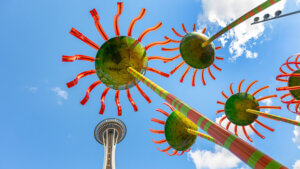
The 60-year-old Space Needle sprouts next to Chihuly Garden and Glass, featuring the whimsical work of Seattle glass artist Dale Chihuly.
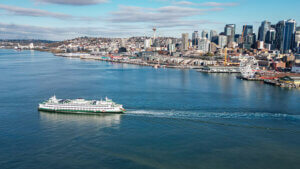
Arty Bainbridge Island, a 35-minute ferry ride across the Puget Sound from Seattle, is a favored spot for corporate retreats and board meetings.
Out and About in Seattle
The Seattle Monorail, which was built for the 1962 World’s Fair, takes visitors to another World’s Fair icon: the Space Needle, which recently underwent a $100-million upgrade focused on making the most of the views from its 600-foot tower. One of the best vantage points is the Loupe Lounge, where you can sip a cocktail seated on the world’s first revolving glass floor. (Pro tip: Time your visit for sunset.) The Space Needle, which resembles a flying saucer, is adjacent to the equally whimsical Chihuly Garden and Glass, where Seattle artist Dale Chihuly’s imaginative glasswork fills both indoor and garden spaces. Popular for receptions and other special events, both are a two-minute tram ride from downtown.
Seattle is a city of neighborhoods, and some of those most popular with visitors are adjacent to or easily accessible from the convention center campus. Just to the north is trendy Capitol Hill, known for restaurants, night life, and a diverse community. I had breakfast at the deliciously down-to-earth Oddfellows Café + Bar in what formerly was a fraternal lodge building. Nearby is the Starbucks Reserve Roastery, a kind of innovation lab and special event center for the world’s largest coffeehouse chain, which was founded in Seattle. Among the roastery’s offerings are coffee cocktails and pairings of chocolate and espresso made from rare beans — the cup I sipped was from the Galapagos Islands.
Pioneer Square — the city’s oldest neighborhood and home to historic red-brick buildings, boutique hotels, art galleries, restaurants, and tech start-ups — offers a diversity of experiences, including the ʔálʔal Café by Chief Seattle Club. The café serves traditional Indigenous foods, including rabbit stew, bison tacos, and cedar tea, and gives 100 percent of its profits to help support unhoused Native individuals. I stopped in to sample the wines at the sleek and comfortable tasting room for Browne Family Vineyards, whose walls tell a story nearly as intoxicating as what was poured in my glass. The proprietor has filled the venue with letters and other memorabilia from his late grandfather, who was a World War II spy.
On my last night in Seattle, I had dinner at 2120, a farm-to-table restaurant in South Lake Union neighborhood, home to tech companies and just blocks from Summit. The restaurant is in the shadow the Spheres, three glass-and-steel domes built as workspace for employees of Amazon, which also was founded in Seattle, and where more than 40,000 plants from 400-plus different species from around the globe are cultivated.
It was a fitting place to end my visit to the Emerald City, given the city’s ongoing commitment to sustainability. In 2005, Seattle City Light became the first electric utility in the U.S. to become carbon neutral, and in 2008, Seattle became the first city in the country to ban single-use straws and utensils in food service. The city could make history again: Last year, the Port of Seattle launched a collaborative effort with major cruise lines and Vancouver, Canada, and Juneau, Alaska, to develop the world’s first cruise-focused, fully decarbonized green corridor, from Seattle to Alaska.
Barbara Palmer is deputy editor of Convene.
